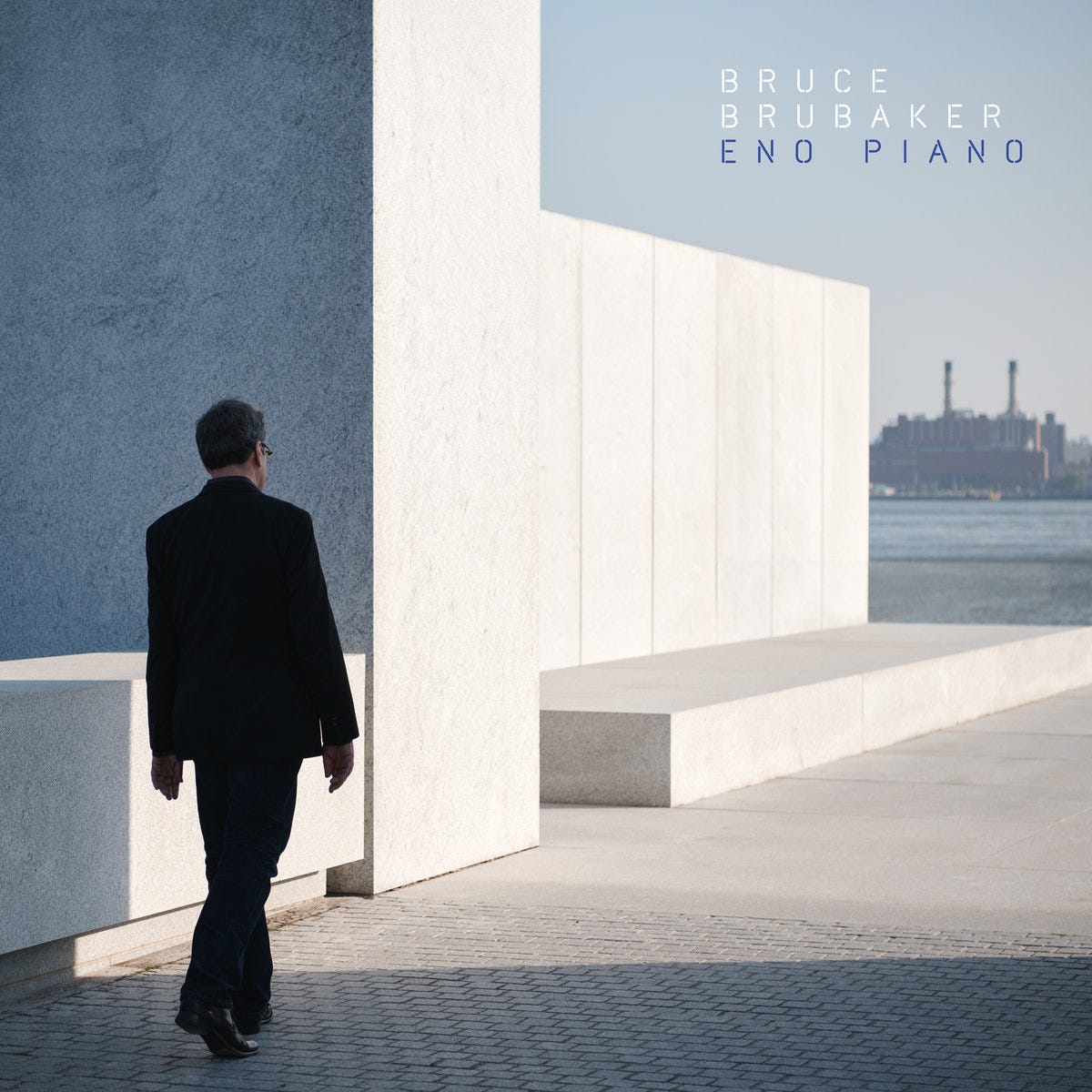Bruce Brubaker (Interview)
Good morning.
Today we’re listening to Bruce Brubaker, an American pianist from Iowa. He studied at Juilliard, gravitating toward modern composers such as John Adams, Meredith Monk, and Terry Riley.1 On Eno Piano, his new album, Brubaker performs six Eno pieces on solo piano. The selections include Music for Airports as well as Eno’s collaborations with Harold Budd and with Jon Hopkins and Leo Abrahams. Brubaker had a deck of Eno’s Oblique Strategies in the studio while making the album, and was inspired by the composer’s ideas to play the Steinway not just by tickling the ivories, but by directly vibrating the strings with an electromagnetic bow. We’re also revisiting Brubaker’s 2015 album, Glass Piano, a companion album to Eno Piano. In our interview with Bruce below, he traces a throughline between Glass and Eno’s music, namely “the listener’s awareness of multiple ways of keeping time that occur simultaneously.”
Eno Piano - Bruce Brubaker (40m, no vocals)
Spotify / Apple Music / YouTube Music / Amazon Music / Bandcamp / Tidal
Glass Piano - Bruce Brubaker (60m, no vocals)
Spotify / Apple Music / YouTube Music / Amazon Music / Bandcamp / Tidal
Tell us about your selection process – how'd you land on these particular Eno pieces? Were there any that just missed the cut?
The project started with the idea of making a piano version of Music for Airports. Three of those tracks are on Eno Piano. (My version of the remaining part of Music for Airports will be released in 2024.) As Eno Piano developed, I wanted to include a few of Eno’s shorter, more linear pieces. All the pieces I recorded share some emphasis on presence in the moment. I like to hear all of Eno’s music as connected and interrelated. A few more of my versions will be coming in 2024: “Failing Light” and “The Big Ship.”
What do you think about Harold Budd's piano playing?
I love Harold Budd’s piano playing! As you listen to Budd’s playing, you are vividly aware that he is hearing the piano. The precise way that a new note comes with an attack, a little intrusion into our consciousness, that then melds into an overall hovering resonance.
Which other ambient composers do you like?
If “ambient” is the appropriate descriptor, I’m a fan of music made by Daniel Lopatin (Oneohtrix Point Never), Sakamoto, and Charlemagne Palestine.
Eno Piano and Glass Piano are companion albums. Tell us about the connection between Glass and Eno, beyond Glass's 1971 performance at the Royal College of Art, which Eno attended along with his friend David Bowie.
For me, a link between Eno’s music and Glass is the listener’s awareness of multiple ways of keeping time that occur simultaneously. In one layer (often low pitches), there can be a slow rate of change taking place; at the same time, on the music’s surface, there is rapid repetitive figuration. It might be like your sense of how fast a car is traveling. Look out the front window — then look out the side window.
What challenges did you encounter adapting multi-track ambient pieces featuring synth and other instruments to solo piano?
My hope was to create multiple layers of sound, with timbral differences, and more importantly, to make simultaneous events seem to be occurring without synchronization. Much of the music was played by me on the keyboard; also, Florent Colautti made electro-magnetic “bows” that we used inside the piano to allow certain piano strings to be set in vibration without obvious beginning attacks. These sounds were sustained to produce long and varied drones. The sounds in Eno Piano are made by an acoustic piano, but there are piano resonances and timbres that have not been heard before.
Name an underrated musician from the past 50 years.
William Duckworth. Listen to The Time Curve Preludes or Southern Harmony.
What non-musical artists inspire you these days?
I am fascinated by the work of Idris Khan. His overlapping of canonic “texts” to make compelling photographic images is remarkable. Somewhat related to Eno Piano, many of the photographs of Sherrie Levine are reworks. See how she appropriates Walker Evans… This connects to the long practice of artists replaying, and reoccupying the art that came before.
What are you working on next?
This summer, I’m going to be recording a mostly improvised album of 2-piano music with the legendary Ran Blake.


